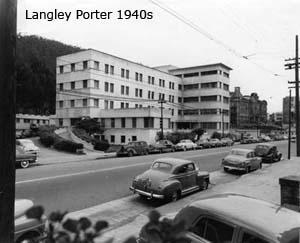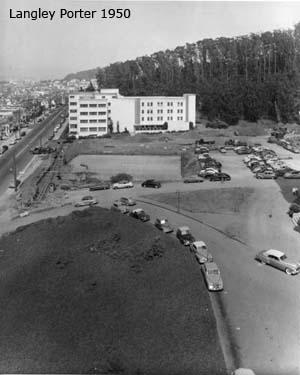Excerpts from Langley Porter Institute and Psychiatry in Northern California: 1943-1975 by Jurgen Ruesch, MD; Published by the Friends of Langley Porter Institute; San Francisco, California, 1978

The natural history of the Langley Porter Institute began with its strategic location that gave it a territory of influence ranging from Mexico City in the south to Alaska in the north, and from Chicago in the east to the Philippines in the west.
The Growth of Psychiatry in the Golden State
Early accounts indicate that the insane were placed aboard abandoned vessels lying in the bay. On October 8, 1849, the town council of San Francisco purchased the stranded hulk of the brig Euphemia for $3,500 and placed it under the authority of the captain of police. The city ordinance authorized the captain "to receive at his discretion any suspicious, insane, or forlorn persons found strolling about the city at night." The Euphemia continued to serve as a retention facility for the criminal and the insane until 1851; thereafter the mentally ill were confined in station houses, which were to become the first asylums. The records show that inmates who were insane numbered 14 in 1850, 22 in 1851, 34 in 1852, and 65 in 1853.
The Origins and Development of the Langley Porter Clinic
The first attempt to erect a psychiatric hospital in the Bay Area was made in 1913 and a bill to this effect was passed by both houses of the Legislature. Insufficient funds, however, prevented Governor Johnson from signing the bill. But the idea did not die. In the San Francisco Examiner of November 24, 1916 there appeared the following entry: "At the next session of the Legislature the State Board of Health will propose a bill carrying an appropriation of $500,000 for the construction and equipment of a state, psychopathic research hospital to be located in San Francisco as one of the Affiliated Colleges group of buildings and to be conducted as an adjunct of the Medical Department of the University of California under the control and direction of the regents of the university.” References to this and previous suggestions to build a psychiatric hospital reappeared in the Sacramento Bee of January 18 and March 23, 1917. However, these considerations were drowned in the uproar over the American declaration of war against Germany on April 6, 1917 and the preoccupation with mobilization. It took an additional 20 years and another world war to finally implement the construction of a psychiatric hospital in San Francisco.

The plan for the first psychiatric institute in California had been cooperatively conceived by Drs. [Robert Langley] Porter, [Aaron J.] Rosanoff, and [Walter L.] Treadway. It was based upon the idea that prevention, teaching, and research in the field of mental disease would be enhanced if the wealth of clinical experience gained from the approximately 29,000 patients than available in the nine California state hospitals could be combined with the expertise of the staff of a medical school. The cornerstone was laid on April 5, 1941, and the institution was named in honor of the Dean of the Medical School who had done so much for its planning -- Robert Langley Porter. At the dedication ceremonies on February 13, 1943, Superintendent of the Compton Sanitarium, Gleen E. Myers, read the inauguration address prepared by Rossanoff prior to his death in January of 1943. He remarked that the Clinic was to be devoted to the training of physicians, psychologists, social workers, and nurses working in the field of neuropsychiatry; he stressed a goal of developing cooperation between psychiatry, neurosurgery, internal medicine, and pediatrics, a practice which was to be achieved by the incorporation of a neurosurgical service and a child guidance service into the structure of the clinic
During the summer of 1941, Dr. Karl M. Bowman was offered the directorship of the new facility, assuming simultaneously the titles of Superintendent of the Langley Porter Clinic and Professor and Chairman of the newly created Division of Psychiatry in the School of Medicine.
When Ronald Reagan became Governor of California, a task force of experts recommended the reorganization of all the health services in the state under one department. It also was suggested that the two psychiatric institutes, located in San Francisco and Los Angeles, be transferred to the jurisdiction of the University of California. Thus, on July 1, 1973, The Langley Porter Neuropsychiatric Institute, by an act of the legislature and with the consent of the Board of Regents, was transferred to the administration of the University. The Institute retains its name, but within the University is now known as an “organized activity." Its director no longer reports of the Department of Mental Hygiene and is directly responsible to the Chancellor of the University. In his functions as Chairman of the Department of Psychiatry, he reports to the Dean of the School of Medicine.
Department Chairs and Directors of the Langley Porter Psychiatric Institute
- Karl Murdock Bowman, MD (1943-1956)
- Alexander Simon, MD (1956-1974)
- Leon J. Epstein, MD, PhD (interim 1974-1975, interim 1985-1986)
- Robert S. Wallerstein, MD (1975-1985)
- Samuel H. Barondes, MD (1986-1993)
- Craig Van Dyke, MD (1994-2008)
- Renée L. Binder, MD (interim 2008-2011)
- Lowell Tong, MD (interim 2011-2013)
- Matthew W. State, MD, PhD (2013-present)





